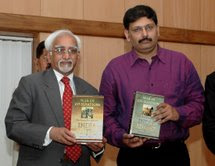Literary Review, The Hindu, 3rd February, 2008


A work of monumental proportions
R.V. SMITH
A goldmine of information for researchers.
War of Civilisations: India AD 1857 (The Road to Delhi and The Long Revolution); Amaresh Misra, Rupa, Rs.2500.
The year 1857 marked a watershed not only in the history of India but of the subcontinent. Call it Mutiny, Revolt or First War of Independence, its impact cannot be belittled. No wonder there is a plethora of publications on it.
To this recently has been added War of Civilisations : India AD 1857 in two thick volumes — The Road to Delhi and The Long Revolution by Amaresh Misra. For those looking for variety in “Mutiny” literature, here is something that satiates both fact and fancy.
The first volume
First The Road to Delhi:
The Battle of Plassey (1757) followed by the Battle of Buxar (1764) put the English firmly on the road to Delhi. A far cry from 1610 when they posed as poor traders in Jahangir’s court at Agra to seek preferential treatment in trading rights in the Moghul empire. How traders became soldiers with territorial ambitions that culminated in India becoming a Jewel in the British Crown is a story of deceit, intrigue and opportunism that acquires the dimensions of a cloak-and-dagger mystery.
Misra highlights all these points painstakingly with the help of documentary evidence, rare photographs and wide-ranging views from Hindu, Muslim, and British sources. He has also brought out the passions, jealousies and ambitions that formed an intricate pattern in human relations in which characters like Umrao Jaan and Azeezun played an emotive role.
The outbreak of the Mutiny, the course it took, the hiding the British got before the recapture of Delhi and Lucknow and other places in North India, the arrest and trial of Bahadur Shah Zafar, the flight to Nepal of Hazrat Mahal of Awadh and her son Brijis Qadar all this and more is recounted in the two volumes with great detail.
The Long Revolution goes beyond 1857 in discussing the Sanatan Dharma Akhadas and reactions in the Haryana-Doab, Bulandshahr, Ranchi, Bengal, North-east, Rajasthan, Chattisgarh, West Coast, Karnataka and Tamil Nadu in the south and international repercussions in Burma, Russia-Turkey, the U.S. All this goes to show the vast expanse on which the Mutiny repercussions where heard.
There is also a chapter on Islam as undivided India’s freedom struggle ideology. Muslims and Hindus where surely united against the firangis but each had his own narrow interest at heart. One wanted the glories of Moghul rule restored while the other had his eyes fixed on the restoration of Hindu ascendancy (brought down by Ghori after the Second battle of Terain and another big defeat by Abdali at the Third Battle of Panipat).
The “coquettish” Rani wanted her Jhansi back while the peasants and tribals had their own agenda. Turkey, with its ruler as the Khalifa of Islam, and Russia as the Big Bear confronting British hegemony in the Big Game all point to multifarious interests.
And to talk of a Shia-Sunni-Sanatani Republican State in Ayodhya Land was at best an illusion of the Begum of Lucknow. The British tightened their grip and continued to rule India for another 90 years after the uprising.
Medley of skirmishes
Instead of being a War of Civilisations, it was a medley of skirmishes in which the Wahabis wanted a Talibanised State and the Hindus the reinstatement of the Peshwa. The Mutiny was great on promises and short on achievements.
Pious intentions alone do not make a revolution. The whole surmise does not stand scrutiny. It was naïve to expect the firangis to be driven away from the country since they controlled the main ports and the coastline with a powerful navy.
The resultant chaos would have helped them to come back and pursue their policy of divide and rule with a vengeance. However this monumental work is a goldmine of information for which generations of researchers will be grateful.



Comments